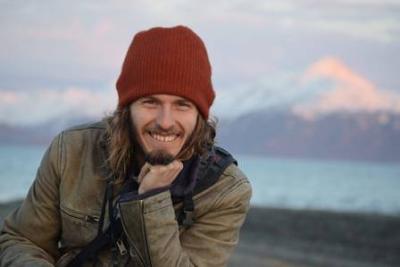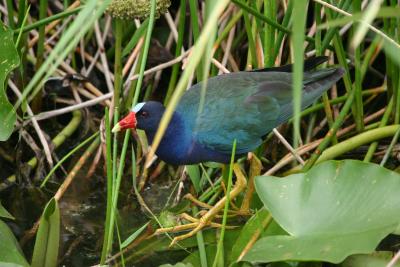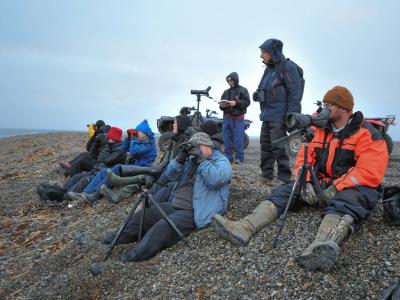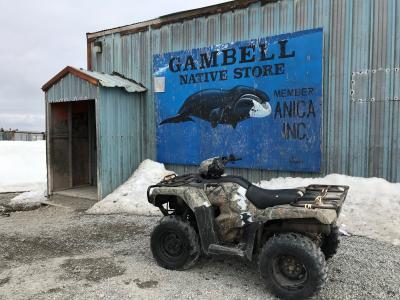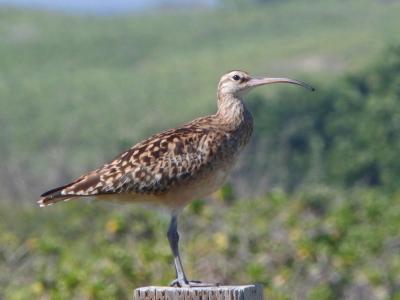Alaska: The Pribilofs and Utqiagvik (Barrow) in Fall
Vagrants and the Ross’s Gull Migration
-
Sep 29 to Oct 6 2025
Raymond VanBuskirk
Ross's Gull Extension (Utqiagvik/Barrow) to Oct 10
2025
2025 Pribilofs Single Room Supplement $960
2025 Utqiagvki (Barrow) Tour Price $2,890
2025 Utqiagvki Single Room Supplement $590
2025
2025 Pribilofs Single Room Supplement $960
2025 Utqiagvki (Barrow) Tour Price $2,890
2025 Utqiagvki Single Room Supplement $590
Alaska’s Pribilof Islands lie in the Bering Sea some 300 miles southwest of Alaska’s mainland. We’ve scheduled an extended stay on the rocky island of St. Paul at a good time for Asian and other vagrants, beyond the breeding season but the sea cliffs and surrounding waters will still have hundreds of alcids and good numbers of the near-endemic Red-legged Kittiwake, and the Northern Fur Seal colony will be overflowing with young seal pups.
For the first time in many years, we’ll return to Utqiagvik (Barrow) in the late fall in hopes of intersecting with the magical Ross’s Gull migration as these extraordinarily elegant small gulls move west to east and past Barrow to feed in the Beaufort Sea before settling in their still-unknown high Arctic wintering grounds. This short tour extension can be taken along with the Pribilofs, or as a separate tour.
Day 1: Our Pribilofs tour begins at 6:00 pm in Anchorage. Night in Anchorage.
Days 2-6: In the morning of Day 2 we may have time to bird around our Anchorage hotel where we’ll focus on species unlikely to reach the islands, perhaps including Boreal Chickadee or White-winged Crossbill. Later in the morning we’ll take the four-hour flight to Saint Paul Island in the Pribilofs. Nights on Saint Paul.
We’ll spend our days on the “Pribs” alternately walking around and scanning the island’s many small lakes and wetlands for waterfowl and waders, scouring the secluded and sheltered sides of hills and patches of taller vegetation for passerines, and, if conditions are advantageous, looking offshore for passing seabirds. The cliffs will be far less crowded than in the summer - breeding is complete - but we’ll be treated to very close views of Horned Puffin and Common and Thick-billed Murres, and should see at least small numbers of the other North Pacific alcids. We’ll certainly see Red-legged Kittiwake and Red-faced Cormorant, the former at its only accessible site in North America. The cacophonous Northern Fur Seal rookeries will be bustling with masses of pups, and spending time with these remarkable pinnipeds gives credence to Saint Paul’s title of the “Galapagos of the North.”
In late-September the Pribilofs are still mostly green with strong hints of autumn in the air. We’ll sift through the throngs of Rock Sandpipers and Ruddy Turnstones for rarer shorebirds; Gray-tailed Tattler, Sharp-tailed Sandpiper, and Common Snipe are all regular late September/early October migrants, and species such as Common Sandpiper and Jack Snipe are possible. Waterbird mega-rarities at this season include North America’s first Solitary Snipe.
Asian landbird vagrants are unpredictable, but late September/early October has produced Sky Lark, Dusky Warbler, Gray-streaked and Taiga Flycatchers, Red-flanked Bluetail, Eye-browed Thrush, Olive-backed Pipit, Siberian Accentor, and Brambling among others. Nights in St. Paul.
Day 7: After a final day at St. Paul, we’ll return to Anchorage in the evening. Night in Anchorage.
Day 8: The Pribilofs tour ends this morning in Anchorage.
For those continuing on to Utqiagvik (Barrow), today is a buffer day in case of weather delays getting off St Paul. Most of today is at leisure, but there will be some time for a bit of light birding locally around the hotel.
Ross’s Gull Extension in Utqiagvik (Barrow)
For a brief window in late September/early October, most of the world’s population of Ross’s Gulls migrate past Point Barrow, west to east, from the Chukchi Sea into the Beaufort Sea. It’s possible to see this migration from shore, and depending on local weather and sea conditions, there may a few to hundreds of these gulls moving past on any given day during this short period.
Day 8 (Day 1 extension): Those doing only the Utqiagvik extension should arrive in Anchorage today. Night in Anchorage.
Day 9: We’ll fly from Anchorage to Utqiagvik, the northernmost point on the North American continent and 300 miles due north of the Arctic Circle. Weather here will be quite different than Anchorage, probably with snow and ice already present.
Days 10-11: We’ll have two full days to explore the roads of Utqiagvik. It will be cold, and the birding time is limited – there are about nine hours of daylight when we’re here - so we’ll focus on Ross’s Gulls. Other notable species might include Snowy Owl, Common, King, and Spectacled Eiders, Yellow-billed Loon, and Black Guillemot. With very good luck (and a carcass on the beach), we might even see an Ivory Gull, another special gull of the high Arctic. Arctic Fox and Polar Bear are possibilities as well.
Day 12: Our return flight to Anchorage is usually in the afternoon, so we should have time in the morning for more birding. The tour ends on our arrival in Anchorage.
Note: The information presented here is an abbreviated version of our formal General Information for Tours to Alaska: The Pribilofs. Its purpose is solely to give readers a sense of what might be involved if they take this tour. Although we do our best to make sure taht what follows here is completely accurate, it should not be used as a replacement for the formal document which will be sent to all tour registrants, and whose contents supersedes any information contained here.
ENTERING THE UNITED STATES: Non-United States citizens need a valid passport and may need a tourist visa. Consult your nearest US Embassy or consulate for details.
HEALTH: Alaska presents no major health hazards. Comfort in Alaska is first and foremost a matter of keeping warm and dry. Warm and waterproof clothing and boots, and sturdy, waterproof walking boots are absolutely essential. Please study the clothing recommendations in the printed General Information.
Insects are a nuisance primarily from mid-June to mid-August, so we normally miss the worst influx. An ample supply of repellent and suitable clothing are the best protection.
Mammals: Although large mammals are potentially dangerous, they pose little threat if a few commonsense rules are followed; your leader will discuss these rules briefly during the introductory meeting. Bears do not occur on St Paul, but polar bears are possible near Barrow, so your leader will give tips on commonsense things to do (such as not wandering off alone!).
PACE OF TOUR: Birding in the Bering Sea Islands in fall is generally more strenuous than in spring. While in the spring most of the islands are covered in snow, or very little vegetation making the area that we can cover relatively small, the fall is warmer, with taller vegetation (even lush in the Pribilofs). To dig out vagrant passerines it is necessary to walk through patches of vegetation and along the leeward side of hills. It is possible for those who wish to walk less to remain by the road and come out only if we find something, but the more people that walk the more we find. Walking through the patches of vegetation is fairly difficult, with uneven footing, hidden holes, and loose dirt. Shorebirds may also require some legwork, although many of the ponds will have nice muddy rings that can be scoped comfortably from a distance. On Saint Paul we have the use of vans, but we may still walk five miles or more over the course of a day (in short stretches). The days will be broken up by meals, with an outing after breakfast, after lunch, and after dinner. Since we use only one lodge, a person can easily opt out of any of the excursions if desired.
Utqiagvik is an altogether different experience in the fall, with snow very possible (even likely). Birding will consist of a few stretches of seawatching, watching specifically for Ross’s Gulls to go by. This extension is not strenuous but will likely be windy and cold.
CLIMATE: Coastal weather is normally cool to cold. Utqiagvik will likely experience freezing temperatures in September. Wind and drizzle or rain can occur frequently, often in rapidly changing combinations. In the Pribilofs, temperatures tend to be a few degrees warmer and occasionally in September folks are walking around in t-shirts and even shorts!
ACCOMMODATIONS: Our Anchorage hotel is a standard, modern hotel.
King Eider Hotel, St Paul, Pribilofs: We will stay in the hotel wing at the airport, a basic but comfortable hallway with 20 rooms and a lounge. Remodels were recently completed and most rooms now have private bathrooms. Please note single rooms may not be available in St Paul. WIFI is either excellent or absent, depending upon the week.
Utqiagvik: We stay in a well-appointed modern hotel near the airport.
DRESS: Informal throughout.
TRANSPORTATION: At Saint Paul and Utqiagvik we will be traveling by 15 passenger vans or small 21 seat buses. The internal flights are on commercial airlines (Alaska Airlines and Ravn Air).
SMOKING: Smoking is prohibited in the vehicles or when the group is gathered for meals, checklists, etc. If you are sharing a room with a non-smoker, please do not smoke in the room. If you smoke in the field, we ask that you do so well away and downwind from the group. If any location where the group is gathered has a stricter policy than the WINGS policy, the stricter policy will prevail.
GENERAL INFORMATION AND CONDITIONS OF WINGS TOURS: Please take a moment to read the General Information and Conditions. This section contains important information about how we conduct tours, e.g., what is included in the tour price, refund and cancellation policies, pace of the tours and other information that will help you prepare for the tour.
ADDITIONAL INFORMATION: A more complete General Information for Spring Alaska: Gambell and Nome will be sent to each registrant on receipt of their booking. Final information with instructions for meeting the group, hotel addresses, etc., will be mailed about three weeks before trip departure. Other news will be communicated as necessary. If you have any questions, please let us know.
2022 Narrative
September 11th: The group gathered in the morning, shortly after breakfast, for introductions and then headed out for a nice half day of birding in the Anchorage area. We’d originally planned to leave for St Paul today but the Ravn Air flight schedule changed somewhat last minute (after we’d all already purchased our arrival flights) so we adjusted our departure flights and added an extra day of birding on the mainland, affording us a few species we would’ve missed on this tour otherwise; birding logistics in Alaska are never straightforward, no matter how hard you try. We started the morning at Connor’s Bog where we had gorgeous views of Pacific Loons in breeding plumage, and sifted through large rafts of ducks including some very nice Barrow’s Goldeneyes. Songbird activity in the northern woodlands is really slowing this time of year but we still managed to encounter a nice mixed flock with fabulous up-close views of Boreal and Black-capped chickadees, Slate-colored Juncos, and Orange-crowned and Yellow warblers. A few folks glimpsed a Brown Creeper moving amongst the other birds in the flock. At the Westchester Lagoon we enjoyed watching the nearby waterfowl, including a couple of Red-necked Grebes still in breeding plumage. This may be the best place on the planet to study the differences between Greater and Lesser scalps. Nearby on the coastal trail we found a small flock of Bonaparte’s Gulls. We stopped for lunch at the Middle Way Cafe and then headed to Potter’s Marsh. On the marsh boardwalk we had a nice view of a Common Merganser and watched a female Mallard choke down a sizable fish, which was a new experience for all of us! On the south end of the marsh was a flock of Trumpeter Swans. After leaving the marsh a few folks headed to pick up some extra gear in town and stopped for ice cream along the way. We enjoyed our first dinner together at Piper’s and went over logistics, birds, and set expectations for the tour.
September 12th: St Paul travel days are always a bit nerve wracking, but the flight left on-time and arrival was smooth, with only a short refueling stop at Cold Bay. Once on the island we were greeted by our fabulous local guides/hosts, Sulli Gibson and Nathan Goldberg. We checked into the hotel as quickly as possible and headed out for a bit of birding before dinner. We hadn’t even left the hotel property before we were enjoying the flocks of Pribilof Island (umbrina) Gray-crowned Rosy-Finches. These Rosies are 20-30% heavier than their mainland counterparts and have very dark brown plumage and all gray heads. We made a quick stop at Weather Bureau Lake to watch the Black-legged and Red-legged kittiwakes bathing in the freshwater. Every now and then the bathing kittiwakes would flutter up out of the water, and hover low over the surface exposing their namesake leg colors. A flyby Rock Sandpiper marked yet another new bird for most folks on the trip. Nearby at Salt Lagoon we spotted the long-staying Steller’s Eider and had our first looks at Red-faced Cormorants marking species number 700 for Steve’s ABA list - congrats! Just around the corner we found a vocalizing Wandering Tattler. After dinner we headed to Pumphouse Lake for a little marsh crawl, flushing Sharp-tailed Sandpipers, Long-billed Dowitchers, Pectoral Sandpipers, and Red-necked and Red phalaropes.
September 13th: We started the day at Marunich Point and wandered along the shoreline hoping to flush passerines from the eroding shoreline. Songbirds were few and far between but the sunrise was spectacular. We enjoyed distant views of Yellow-billed Loons, and a very large raft of King Eiders. Further down the shoreline we had spectacular views of a vocal Gray-tailed Tattler dancing along the surf line, practically at our feet. After Marunich we headed to Main Crab Pots for our first round of pot-whacking! We didn’t find much in the way of songbirds but we did have some very nice views of the local subspecies of Pacific Wren.

The local island subspecies of Pacific Wren trying to figure out why we’re walking around the crab pots hitting them with a pole (above). Photo: Raymond VanBuskirk
In the afternoon we visited Reef Cliffs and Seal Blind for some up-close looks at the island’s nesting seabirds and thousands upon thousands of Northern Fur Seals hauled out along the shoreline - the sights, sounds, and smells are not likely to be forgotten anytime soon.

One of the Northern Fur Seal pups (above). Note the external ears, differentiating them from the Sea Lions. Photo: Raymond VanBuskirk

Don’t mess with me! Subadult Northern Fur Seal (above). Photo: Raymond VanBuskirk

A Northern Fur Seal trying to be a Glaucous-winged Gull (above). Photo: Raymond VanBuskirk

A breeding plumage Tufted Puffin at Reef Cliffs (above). Photo: Raymond VanBuskirk
As we were making our way back toward the middle of the island we got a call from Sulli - male EURASIAN BULLFINCH in the Kamanista Quarry! Nathan stepped on the gas and before long we found ourselves in an old collapsed lava tube, surrounded by massive rocks, looking for a single bird (though thankfully very distinctive). Shortly before we arrived it flew off with a group of Snow Buntings and now our job was to refind it. I took the upper level of the quarry while the rest of the group walked with Nathan and Sulli below. As we neared the end of the quarry Nathan glimpsed the bird as it flushed off-trail into the “upper cut”, a particularly treacherous section of the quarry. Nathan and I elected to climb up into the uppercut and navigate the unstable rocks and deep trenches to try and bring the bird back around for folks to view. We did eventually refind it, but it wasn’t cooperating, and eventually we decided we’d need to flush it all the way down the length of the upper cut before we could get it back in the main canyon where participants could hope to see it. Some time went by but things were playing out just as we’d hoped. We coordinated with Sulli to get the group in position and we made a final gentle push, sending the spectacular finch over the lip of the quarry and right into everyone’s view. High-fives and joyful chatter all around! Once back in the main canyon we were able to study it for prolonged periods in the scope. This is only the 6th island record, and the first since 2012, it also marks the earliest record ever for Alaska. The trip was arguably made by this bird, but many others lied ahead.

The absolutely jaw-dropping male Eurasian Bullfinch in the Kamanista Quarry (above). Photo: Raymond VanBuskirk

Lots of happy birders! The Eurasian Bullfinch was a lifer for everyone on the island, including all leaders (above). Photo: Raymond VanBuskirk
September 14th: We spent the morning hunting for more vagrant passerines around the island without much luck but we did bump into a couple of very nice Slaty-backed Gulls on the Zoltoi Sands beach. We also stopped to have another look at the family of Arctic Foxes at Salt Lagoon harbor.

An up close look at a St. Paul Island Arctic Fox (above). The foxes on the island all have beautiful dark grey or black coats. Photo: Raymond VanBuskirk
In the evening we went on a good ole fashion snipe hunt at the Antone Sough, where a Common had been seen earlier in the day. After a lot of walking, and some circling back, we were able to flush the Common Snipe. Most views were in less than ideal lighting but the leaders manahed to get a few photos, while others in the group were able to make observations of the pale underwing coverts and thick white trailing edge to the wing. Nathan’s photos of the snipe were particularly reassuring since Raymond and Sulli’s were a bit underexposed giving the underwings a grayish appearance (whoops).
September 15th: Though not originally planned this way, today was our new departure day since a very large storm was making its way to the island from the Japanese coast and winds were expected to blow up to 90 mph, potentially causing a massive storm surge. Our regularly scheduled flights weren’t to leave until the 16th but the airline had already canceled that flight due to storm predictions with no other flights coming in for multiple days. We elected to bird like crazy until just before the afternoon flight back to the mainland. We birded hard, starting the morning at Ridge Wall, where we stood in awe as Northern Fulmars, both puffin species, Red-faced Cormorants, and Red-legged Kittiwakes made close flights along the edge of a steep cliff that plummeted hundreds of feet down to the ocean below. Sometime in the days leading up to today the Red-legged Kittiwakes made their mass exodus off the nesting cliffs but there were still a few immature in the area and at least one adult flew in and perched on the cliff, showing off its waxy red legs and feet.

Horned Puffin tucked away on a cliff edge (above). Photo: Raymond VanBuskirk

Immature Red-legged Kittiwake riding the wind at Ridge Wall (above). Photo: Raymond VanBuskirk

A Northern Fulmar inspects the group from the safety of the wing (above). Photo: Raymond VanBuskirk

Red-faced Cormorants are spectacular when seen in good lighting (above). Photo: Raymond VanBuskirk
On the way back from the cliffs were stopped to scan Antone Slough for the long-staying Brant and Eurasian Wigeon. The Brant was there but there was no sign of the wigeon. As we were preparing to move on Nathan called Raymond over to his scope to confirm that he wasn’t losing his mind - it was the Spotted Redshank, tucked all the way on the far end of the lake in a tiny marshy cove. This bird had arrived in the week leading up to our trip but disappeared shortly before we got there. What a treat to see this mega rare shorebird, and only hours before our early departure. We made our way around the lake and walked in for closer views! There were celebrations all around. With only a little time left before departure we made our way out to Little Polovina Lake and finally connected with a Eurasian Wigeon which was new for the trip. We headed back to airport, said our goodbyes, and headed back to the mainland after an absolutely fabulous few days on the island.

Spotted Redshank with a Ruddy Turnstone in the back (above). Photo: Raymond VanBuskirk

Sunrise over the celery (above). Photo: Raymond VanBuskirk
Raymond VanBuskirk is an exceptional field birder. I have been birding for over 40 years and he is one of the very best birders I have ever birded with. He seems to have excellent vision which helps him ID some birds at further distances than I can.
- Tim J. on Alaska: The Pribilofs and Utqiagvik (Barrow) in Fall
Single rooms may not be available in St Paul but won’t be a problem in Anchorage or Utqiagvik.
Maximum group size 10 with one leader, 14 with two leaders.



































